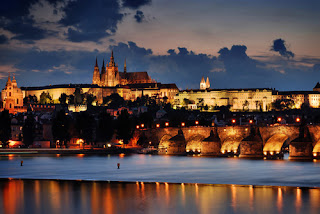A mosaic of different styles
The
Times of construction and a time of destruction!
This castle (palace) is located in the
Charles sets the ball to roll, a non-stop roll!
Since Charles IV set the ball of construction rolling in the 14th century, the ball went on rolling for centuries; undergoing several building, rebuilding as well as destructions. The Prague Castle has seen several ups and downs in its life of long twelve centuries (it was originally a 9th century structure); a large fire that broke out in 1541 destroyed almost all of the structures, the Bohemian revolts 1618 had its impact on this monument, in 1648 the Swedes barged in to the complex and looted all valuables especially those invaluable collection of the Rudolf era. Fortunately all destructions were succeeded by creations and the monument gained new life each time. The role of adding beauty to this castle/palace goes to Ladislaus 11 Jagellos who rebuilt it in to the present style under architect Benedict Rejt, the Vladislav hall is his addition. In 1541 King Rudolf started the work of the Spanish Hall and the work had to be completed by Empress Maria its architect was M. Picassi.
Works that took several generations to complete
This big complex that includes palace, Spanish Hall, President’s office, six gardens, a deer mot, Cathedrals of St. Vitus, St. Wenceslas, St. Albert’s etc.
The original Gothic style St. Vitus Cathedral was constructed by John Luxemburg and his two sons in the 9th century; there after it had undergone many reconstructions, the present structure built on 1929, it is the spiritual symbol of the entire nation of Czech Republic. St Wenceslas Chapel is a brilliantly decorated one using frescoes and precious stones, it was built by Parles. The former Bohemian emperor’s crown and jewels are kept in this chapel. The
The oldest and most revered structure that stands in the complex is the St. George Basilica a Romanesque structure built in 920 (rebuilt in 10th and 12th centuries very close to the Monastery of Benedict.
The Golden Lane is perhaps the most memorable buildings; a housing complex intended for the accommodation of riflemen of the castle. The significance is that Franz Kafka the ‘existentialist giant of the yesteryears’ lived here during 1916-17.
A mosaic
The entire complex can be compared to huge canvas (570 meters long and 130 meters wide) on which architectural styles of different regions and different eras are drawn by generations of artists thereby making it wonderful mosaic different forms of architectures. Those who stare it with awe are not only ordinary tourists who visit this site in large numbers but even the head of states who pay visit to this republic as part of their official tour.
Preparation for an event
One of the important events of the nation that was planned to take place in
History never rests
The Russian invasion of
No windows, no tunnels, there may be stooges lurking!
Public were prohibited from entering in to the complex as there may be any capitalistic stooges among them! Huge power generating systems and transformers were installed spoiling the tranquility of the area; for fear of getting the complex surrounded by the ‘bourgeois enemies’. The underground tunnels which accessed the tombs of buried former kings were blocked as bourgeois may sneak in to the fort through them! An aviary with lovely birds was removed from the site and all windows of the cathedral and presidential palace covered by bricks to ensure maximum safety as stooges may peep and leak out official secrets!
No bricks, no barbed wires, could save them!
Alas no fort or bricks could save that regime; in the democratic whirlwind that swept all over East
Prague Castle at present
At present this site remains as the most sought after location in the Republic of Czech, it houses several museums like National Gallery of Bohemian Baroques (a style that was popular in 17th century originated from Rome) and Mannerisms, exhibition dedicated to Czech History, an elaborate toy museum packed with ethnic toys and a Picture Gallery. Two churches, six palaces, seven gardens, nine other structures of historical importance, a deer park etc make this complex a very elaborate location. Some structures and alternations made by erstwhile Communist Era are also retained for the memory of a bygone time to keep the memory fresh!





hello sasisar,
ReplyDeletei have gone throgh your PRAGUE ARTICLE, ITS quite wonderful and
discriptive, hope more attractive castles will shine in future. manoj
hi sasi sir,
ReplyDeletegonethrough the article.fine